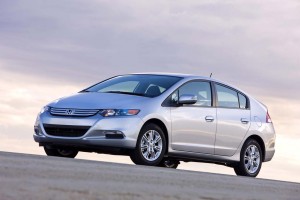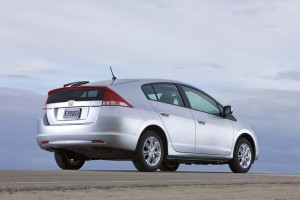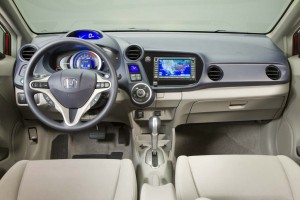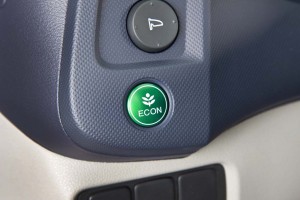
The original hybrid was a teardrop-shaped two-seater. With the launch of the 2010 Honda Insight, the automaker adopts a more conventional four-door design that's still distinctive as a hybrid-only model.
The original, 2000 Honda Insight was the first hybrid-electric vehicle to reach North American shores and it was certainly no trouble to spot it rolling down the road, thanks to its unusual, teardrop-shaped aluminum body. But the 2-seat design had limited functionality for most Americans and despite its incredible mileage, it quickly slipped in the sales charts and was pulled from the market in 2006.
There were high expectations when the Japanese maker announced plans to launch a new hybrid using the Insight name, and that it would be affordable, distinctive and, this time, for more functional than the original.
There’s no question the 2010 Honda Insight lives up to the first two goals, while also delivering solid fuel economy. But after spending a week behind the wheel, TheDetroitBureau.com found some serious drawbacks to the design that potential buyers should be clearly aware of before signing on the proverbial dotted line.

Though based off the subcompact Fit, the 2010 Honda Insight is slightly bigger and roomier, but a lack of rear visibility is a key drawback.
Despite getting a jump on Toyota, its primary HEV competitor, Honda has failed to make any significant inroads on U.S. sales charts. Conventional wisdom suggests that may be the result of its decision to load its gas-electric powertrains inside otherwise conventional-looking models, like the current Civic Hybrid, rather than coming up with distinctive, standalone models like the Toyota Prius.
So, this time, Honda has come up a hybrid design you can spot at a distance. The 2010 Insight is largely based on the smallest car Honda now sells in the States, the Fit, though the hybrid has been stretched by about 3 inches and measures an inch wider. Visually, there’s not much similarity at all. If anything, the Insight pays homage to the old Honda CRX hatchback – but the high-tailed fastback design is, ironically, the source of some of our biggest problems with the new hybrid.
The long sloping tail of the 2010 Honda Insight may look intriguing, but it makes it extraordinarily difficult for a driver to see out of. And it doesn’t matter whether you’re short or tall, sit high in the driver’s seat or lean back as far as possible. The crossbeam that bisects the back glass will get in your way. And we found the sideview mirrors had issues of their own.

The 2010 Honda Insight features a clean if relatively no-frills interior. There's plenty of cargo space but the back seat is cramped.
That said, the interior is reasonably well executed for a car with a rock-bottom price (for a hybrid, anyway, at a base of $20,510 plus delivery charges). There’s nothing fancy. It’s your basic plastic interior, though Honda does seem to always put it together well, with perfect fit and finish and well-executed graining and detailing. But it’s no fancier, to our eyes, than the entry-level Fit – but for the display screen that can be used for navigation and to read out the way the hybrid drive system is operating at any given moment.
Seating is acceptable but we were happy to wrap up after a couple hour drive. Rear legroom is a bit cramped, but there’s plenty of luggage space, thanks to a flat-bottomed cargo compartment that offers about 1.5 cubic feet more room than the Prius.
Honda and Toyota have two very divergent views on gasoline-electric technology. The bigger maker’s Synergy Drive system is a sophisticated “full” hybrid, which can run on gasoline or electric power, or a combination of the two. Though Honda bridles at the term, it has opted for a “mild” hybrid, which cannot be driven in battery mode alone. As with a Toyota hybrid, Insight will briefly shut off when idling, say, at a stoplight. But the electric portion of the 1.3-liter Integrated Motor Assist, or IMA, powertrain kicks in only when an extra boost of power is needed, such as when you take off from that stoplight.

The Eco Assist system on the 2010 Honda Insight reportedly can yield another 10% in fuel economy - but it is not for those looking for a fun-to-drive experience.
It is, most notably, a less expensive technology, especially with revisions made in the latest version of the Honda system, which reportedly costs the maker about 50% less to produce than the similar gas-electric powertrain in the current Civic Hybrid. Honda had hoped this would give the 2010 Insight a clear cost advantage over the more complex Prius – but, it turns out, it simply forced Toyota to introduce a “stripper” version of the third-generation Prius, pricing it at just $22,750 – if you can find one in this configuration.
The $2,000 price advantage still has its appeal, as do the car’s 40 mpg City, 43 mg Highway federal fuel economy numbers. On the other hand, Prius has a 51/48 rating, and unlike past versions, the third-generation Prius does seem to be delivering pretty close to what the sticker says it should under normal driving conditions. With the Insight, you’d burn roughly 360 gallons a year if you put on 15,000 miles annually. With the Prius, you’d need about 300 gallons. If you assume fuel prices will push to at least an average $3 a gallon over the life of your next car, you’d save about $180 annually with the Prius, not necessarily enough to justify the higher cost.
Of course, there are other options out there, such as the Ford Fusion Hybrid, which, like Prius, can operate on battery power alone for short jaunts at low speed. It’s rated at 41 City/36 Highway. It’s a larger car, but you’ll also pay $28,350. Then there’s Honda’s own alternative, the Civic Hybrid, which gets 40 mpg around town, 45 on the highway, but goes for $24,360 – and doesn’t have that “look at me, I’m a hybrid” styling.
The other alternative, of course, is the diesel, and there’s a small but growing line-up of oil burners, notably from German makers like Volkswagen. The big advantage here is that diesels make better mileage in highway driving, where hybrids provide the least advantage (notice several models, above actually get lower Highway EPA ratings).
Another drawback with hybrids is the actual driving experience. True, many HEV buyers are more focused on the good they’re doing for the environment, but not all have lost that sense of fun you get with a little performance.
The 2010 Honda Insight doesn’t make claims to being a rocket, not with a peak output of just 98 horsepower, though it does better than that anemic number might suggest. In standard mode, the hybrid offers acceptable acceleration and reasonable handling, though we’d opt for the Civic Hybrid over the new model, which is definitely more fun to drive. The Insight will hit 60 after an 11 second run, about 2.5 seconds slower than the Fit. And that’s if you don’t switch to ECO mode.
Your right foot has more influence on mileage than almost anything else. And most drivers simply don’t know how to maximize fuel efficiency, Honda has determined. So it has added Eco Assist to the 2010 Insight. The car’s data display helps a driver keep a steadier, smoother foot, for one thing, with the speedometer glowing green when you’re doing a good job. Eco Assist also tends to smooth out these little nudges you inadvertently give to the throttle pedal, while also making the A/C and other systems operate more efficiently. All told, Honda claims Eco Assist can improve fuel economy by about 10%.
If that’s what motivates you, the 2010 Honda Insight might just be what you need, especially if you’re on a tight budget – and if you’re willing to overlook the lack of rear visibility. The new hybrid might also appeal to those who have Prius envy – those who want family, friends and strangers alike to immediately know their commitment to the environment – but don’t want to buy a Toyota. Honda’s new offering is an acceptable solution, but one without much passion and with a few other notable flaws. But as an affordable alternative, it will likely wind up on lots of shopping lists.
